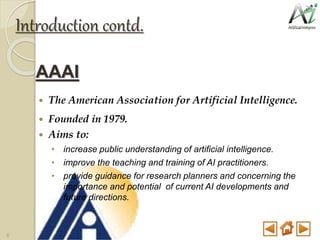Artificial intelligence submitted by shiv
- 1. 100 hours ITT Project Report Submitted by : Shivkant bindal Roll no. : 58 Registration no.: NRO0289400 Batch : December 12’ morning batch(sec B) Submitted to: Mrs. Suminder kaur (Faculty ROHINI ITT CENTRE) 1
- 2. 2
- 3. Acknowledgement “NO LEARNING IS PROPER & EFFECTIVE WITHOUT PROPER GUIDANCE” We wish to express our deep gratitude to our imminent ITT Teacher Mrs. Suminder Kaur who has been a guiding spirit behind the completion of this project. For any errors or inadequacies that may remain in this work, of course, the responsibility is entirely our own. 3
- 4. INDEX Introduction Flashback Turing machine Timelines Goals Branches Categories Applications Achievement- robotics Examples Pros & Cons Conclusion 4
- 5. Artificial intelligence (AI) is the intelligence of machines and robots and the branch of computer science that aims to create it. These machines are highly technical and specialized. John McCarthy, who coined the term “artificial intelligence”, in 1955, defines it as "the science and engineering of making intelligent machines.“ 5
- 6. Introduction contd. AAAI The American Association for Artificial Intelligence. Founded in 1979. Aims to: • increase public understanding of artificial intelligence. • improve the teaching and training of AI practitioners. • provide guidance for research planners and concerning the importance and potential of current AI developments and future directions. 6
- 7. Flashback artificial intelligence The 1956 Dartmouth conference was the moment that AI gained its name, and is widely considered the birth of AI. In 1950, Alan Turing published a landmark paper in which he speculated about the possibility of creating machines with true intelligence. The Turing Test was the first proposal in the philosophy of artificial intelligence. 7
- 8. TURING MACHINE •Turing Machine manipulates symbols contained on a strip of tape. Turing Machine (1937) The Turing test is a proposal for a test of a machine's ability to demonstrate intelligence. 8
- 9. Important Timeline of AI Year Development 1915 Leonardo Torres build Chess automation 1941 Konrad Zeus build first program controlled computer 1945 Evolution of Game theory in AI 1950 Alan Turing proposes the Turing Test 1956 AI introduced worldwide from Dartmouth Conference 1958 John McCarthy invented LISP programming language 1957 GPS demonstrated by Newell, Shaw and Simon 1965 Edward Feigenbaum initiated Dendral 1993 Polly( a behavior based robot) by Ian Horswill 2007 Blue Brain, a project to simulate brain at molecular level 9
- 10. Goals of A.I • To build system that exhibit intelligent behavior. • To understand intelligence in order to model it. • To increase our understanding of perceptual, reasoning and learning . • To design and construction of useful new tools in science, industry, and culture . 10
- 11. Branches of Artificial Intelligence • Perceptive System A system that approximates the way a human sees, hears, and feels objects. • Vision system Capture, store, and manipulate visual images and pictures. • Expert system Mechanical and computer devices that performs tedious task with high precision. 11
- 12. Branches of Artificial Intelligence contd. • Learning system Computer changes how it function or reacts to situation based on feedback. • Natural language processing Computer understand and react to statements and commands made in a “natural” language, such as English. • Neural network Computer system that can act like or stimulate the functioning of the human . 12
- 13. Categories of AI Conventional AI :- Conventional AI mostly involves methods now classified as machine learning, characterized by formalism and statistical analysis. This is also known as symbolic AI, logical AI, neat AI and Good Old Fashioned Artificial Intelligence(GOFAI). Methods include: Expert systems: apply reasoning capabilities to reach a conclusions. An expert system can process large amounts of known information and provide conclusions based on them. Case based reasoning Bayesian networks Behavior based AI: a modular method of building AI systems by hands 13
- 14. Computational Intelligence (CI) Computational Intelligence involves learning. Learning is based on empirical data and is associated with non- symbolic AI, scruffy AI and soft computing. Methods Include: • Neural networks: systems with very strong pattern recognition capabilities. • Fuzzy systems: techniques for reasoning under uncertainity, has been widely used in modern industrial and consumer product control systems. • Evolutionary computation: applies biologically inspired concepts such as populations, mutation and survival of the fittest to generate increasingly better solutions to the problem. These methods notably divide into evolutionary algorithms (e.g. genetics algorithms) and swarm intelligence Categories of AI contd. 14
- 15. Applications of A.I. Expert System Auto programming Game playing Speech recognition Finance hospital 15
- 16. Expert Systems What is an Expert System? An expert system is a computer program that is designed to hold the accumulated knowledge of one or more domain experts Why use an Expert System? Experts are not always available not reliable and consistent. Examples Expert systems in the fields of accounting, electronic chip design, medicine, financial service, etc. 16
- 17. Auto programming What is Auto Programming? It is a type of program which generate its own piece of program which further helps a programmer to write a code. Why to use auto programming? It allows human programmers to write code at higher abstraction level Examples IDEs such as Eclipse, Interface Builder and Microsoft Visual Studio 17
- 18. Video game artificial intelligence is a programming area that tries to make the computer act in a similar way to human intelligence. In 2001 the game Halo featured A.I. that could use vehicles and team tactics. The AI could recognize threats such as grenades and incoming vehicles. GAME PLAYING 18
- 19. Getting a computer to understand spoken language and react appropriately. Convert the input speech into another medium, e.g. text It requires quiet environment. Example: • united airlines has replaced its keyboard tree for information by a system using speech recognition. • Smart phones which work as personal assistant. SPEECH RECOGNITION 19
- 20. To organize operations, invest in stocks, and manage properties. In August 2001, robots beat humans in a simulated financial trading competition. Websites such as, “Creative Virtual.com” has deployed artificial intelligence customer support systems, or automated online assistants, at HSBC, Intuit and Lloyds Banking Group, to assist customers with services such as checking an account balance. Finance 20
- 21. • To organize bed schedules, make a staff rotation, and provide medical information. • Help scan digital images, e.g. from computed tomography ,i.e., CT Scan for typical appearances and to highlight conspicuous sections, such as possible diseases. A typical application is the detection of a tumor. Hospital 21
- 22. Robotics Meaning Of Robot • Robot Institute of America defines robot as, “A reprogrammable, multifunctional manipulator designed to move material, parts, tools, or specialized devices through variable programmed motions for the performance of a variety of tasks.” • Robots may be one of the most well known examples of Artificial Intelligence. • Example, mars-rover designed by NASA. The Biggest Achievement In AI 22
- 23. Components of robotics Manipulation Robots need to manipulate objects; pick up, modify, destroy, or otherwise have an effect. Thus the "hands" of a robot are often referred to as end effectors while the "arm" is referred to as a manipulator. Actuation Actuators are like the "muscles" of a robot, the parts which convert stored energy into movement. By far the most popular actuators are electric motors that spin a wheel or gear, and linear actuators that control industrial robots in factories. Sensing Sensors allow robots to receive information about a certain measurement of the environment, or internal components. This is essential for robots to perform their tasks, and act upon any changes in the environment to calculate the appropriate response. 23
- 24. Types Of Robots Pick and place • Moves items between points Continuous path control • Moves along a programmable path Sensory • Employs sensors for feedback 24
- 25. Pick and Place Moves items from one point to another Does not need to follow a specific path between points Uses include loading and unloading machines, placing components on circuit boards, and moving parts off conveyor belts. 25
- 26. Continuous path control Moves along a specific path Uses include welding, cutting, machining parts. And also using in paint shops In car factories for spraying paint with high level of . accuracy. Robotic seam welding 26
- 27. Sensory Uses sensors for feedback. Closed-loop robots use sensors in factories with actuators to gain higher accuracy in work. Uses include mobile robotics, telepresence ,microchips or the products related with sensors e.g.:-Camera’s, mobile phones ,etc. 27
- 28. Examples Of A.I Movies Smart Car Smart Phones Military 28
- 29. AIAND MOVIES In today’s generation, movies are mostly about androids, humanoids, and robots. Machines going out of control Replacing humanity World domination LIST OF SOME OF THE HOLLYWOOD MOVIES ON AI: 1. The Terminator (1984) 2. 2. The Original Star Wars Trilogy (1977-1983) 3. Blade Runner (1982) 4. Wall-E (2008) 5. Transformers (2007) 6. The Matrix (1999) 7. Robocop (1987) 8. Alien (1979) 9. Artificial Intelligence: A. I. (2001) 29
- 30. SMARTCAR Speech recognition Up-to-date information about historical landmarks and points of interest on the car’s rout. Lowest price gas stations close to the current position of the car. Warns drivers of road hazards A.I. In Military 30
- 31. Smartphone (Samsung Galaxy S3) Smart Stay • Smart stay is AI software which take a look on your eyes movements . • Samsung puts it, “The Galaxy S3 Knows When You're Awake". Turn over • Turnover is another simple idea of AI. • It turns the phone to silent. 31
- 32. A.I.INMILITARY The U.S is spending as much 100 billion dollars to develop robots . These robots can aid or replace human soldiers on the front line. These robots can operate in combat zones with little supervision. Flight simulations and virtual environments help train over 500,000 Soldiers. 32
- 33. ADVANTAGES As the level of AI increases so will their competency to deal with difficult, complex even dangerous tasks that are currently done by humans. Machines have no need for sleep, they don't get ill , there is no need for breaks, they are able to go, go, go! Used by scientists to test theories and notions about how our brains work. 33
- 34. Disadvantages AI in some of the autopilot setting caused few airlines to crash. AI in warfare is producing huge damage worldwide loss of lives and money. People might lose their jobs to automation. AI lead to massive structural unemployment. 34
- 35. Conclusion •We conclude that if the machine could successfully pretend to be human to a knowledgeable observer then you certainly should consider it intelligent. •AI systems are now in routine use in various field such as economics, medicine, engineering and the military, as well as being built into many common home computer software applications, traditional strategy games etc. •AI is a branch of computer science that is concerned with the automation of intelligent behavior. •Though fast-growing, AI has never actually caught up with all the expectation imposed on it. •Conclusionally, AI is a young, energetic, and attractive science. 35
- 36. Bibliography Website or Webpage • http://www.forbes.com/2009/06/22/singularity- robots-computers-opinions-contributors-artificial- intelligence-09_land.html • http://en.wikipedia.org/wiki/Artificial_intelligence • And our itt friends 36
- 37. Thank you 37
Editor's Notes
- #7: is a nonprofit scientific society devoted to advancing the scientific understanding of the mechanisms underlying thought and intelligent behavior and their embodiment in machines.
- #19: One of the most studied and most interesting areas of A.I. is game playing.
- #21: X-ray computed tomography, also computed tomography (CT scan) or computed axial tomography (CAT scan), is a medical imaging procedure that utilizes computer-processed X-rays to produce tomographic images or 'slices' of specific areas of the body.
- #23: A robot is a mechanical device that can perform tasks automatically.
- #28: Actuators are like the "muscles" of a robot, the parts which convert stored energy into movement





































